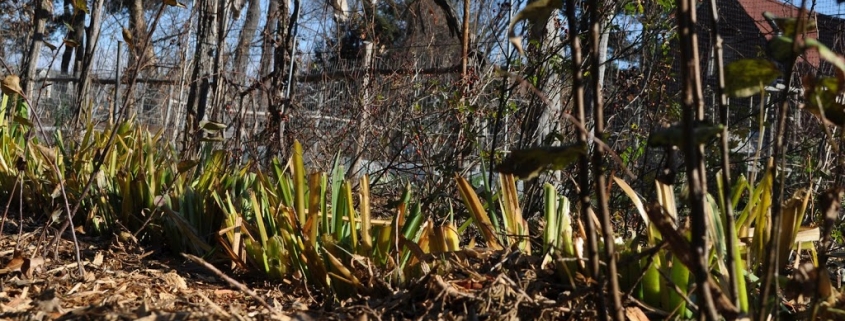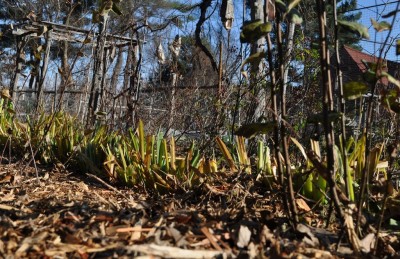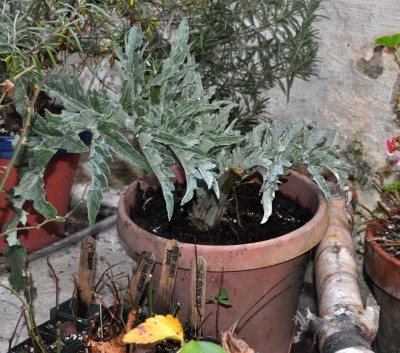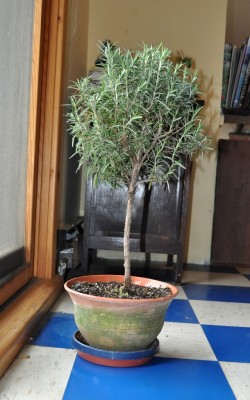Thanks(soil)giving, Chokes, & Rosemary
As part of my Thanksgiving celebration, I’m thanking the soil. Soil, after all, is where it all starts. We’re thankful for the plants, but the plants got where they got because of the soil, offering plants support, water, air (which roots need), a friendly microbial environment, and nourishment.
Basically, I thank the soil with organic materials, that is, stuff that is or was living. Stuff like wood chips (dead), straw (dead), compost (living and dead), manure (living and dead), and autumn leaves (dead). Organic materials are what put the “organic” in organic gardening and farming. Organic materials are bulky, and are what chemical fertilizers have too often replaced. Compost, for instance, is about one percent nitrogen, so to supply the average 2 pounds per 1000 square feet of actual nitrogen needed would require 200 pounds of compost. Opt for 10-10-10 chemical fertilizer and a mere 20 pounds per 1000 square feet would do the trick.
Oh, but that 180 pound difference between compost and 10-10-10 offers so much more than just nitrogen. Compost serves up a smorgasboard of nutrients reflecting the diversity of what went into the compost pile. Just about everything goes into mine, including orange peels from California, olive pits from Peru, even my old Levi’s in addition to garden and kitchen waste, hay, and manure.
That’s not all: Compost and, as they decompose, other organic materials, offer a witch’s brew of natural compounds that improve plant nutrition by unleashing nutrients from the soil’s rocky matrix and rendering nutrients already in the soil even more available to plants. As important, these organic materials help soils hold both water and air, and provide a congenial, nutritive environment for beneficial organisms that help plants fend off diseases and further abet plant growth. Whew! That’s a lot of goodness.
So I’m hauling cart after cart of organic materials. Vegetable beds get an inch depth of crumbly, dark, pleasantly fragrant compost from piles built last year. Paths in vegetable gardens get wood chips. I am mulching berry plantings with wood chips or leaves, according to what’s available and my whims. Leaves that drop from the chestnut trees will be supplemented with leaves that neighbors with leafier yards need to discard. Other trees get wood chips. Fruit trees get rotted leaves, which are very similar in composition to compost in addition to wood chips and, possibly, horse manure with wood shavings.
I hope to finish soil Thanksgiving before the first snow that stays.
————————————————————-
My gut reaction is to shy away from eating any plant with “choke” in its name. Chokecherries (Prunus virginiana) are not for me. I did once grow chokeberry (Aronia spp.), which lived up to its name; the plant is long gone. Chokeberry is said to make a tasty jam or juice, which I realized, anything can if given enough sweetener, dilution, and addition of other flavors.
Artichoke is one “choke” worth growing; its “choke” comes not from the throat but from the Arab name for the plant, al-qarshuf. The problem is that artichoke is one choke that isn’t very happy here. It needs mild winters and summers not searing, which are conditions you might find right along the coast in California or the Mediterranean. So, of course, I am growing it here in New York’s Hudson Valley.
I grew artichoke years ago and did harvest a few small buds; this year I was hoping for at least larger buds. Imperial Star is the variety recommended for northern gardens because it forms buds the first year so can be grown as an annual. Not mine. I sowed seeds early this spring after giving this perennial the cold treatment necessary to fool it into thinking it’s gone through a mild winter and can begin flowering. Imperial Star is more easily fooled than other varieties. Plants given to a friend did make a few small buds but my plants just grew. (Northern Star is another, newer possibility for northern gardens because it allegedly survives winter temperatures below zero degrees F.)
No need to throw in the towel in growing artichokes, though. Among my last activities in the vegetable garden is to dig up one artichoke plant, pot it up, and overwinter it in a bright window in my cool basement. I’ll give it a head start in the greenhouse in spring, then plant it outdoors again when the the weather warms. If the harvest is nonexistent or unreasonably small, I’ll abandon artichoke growing for another 15 years.
————————————————————–
Increasingly, my attention is turning indoors. It has to, with all the thirsty plants now sitting in sunny windows. One of the thirstiest, oddly enough, is rosemary. Too many rosemary plants towards the end of too many winters have surprised me by all of a sudden, when brushed against, shedding leaves, dried and dead, as were the plants.
As a Mediterranean plant, you’d assume it likes dryish condition. It does like its head dry, at least in summer. Stiff leaves make it hard to tell when rosemary is thirsty. They don’t wilt, they just dry up and die.
So now I err on the side of too much rather than too little water. With extra perlite, my potting mix is well-drained, making too much water hardly a problem as long as the saucer beneath the plant isn’t filling with water. The best way to tell whether or not a rosemary plant is thirsty is to feel the weight of the pot.
Except for one rosemary plant conveniently growing in the kitchen, the others are spending winter in the basement, along with the artichoke.







I think I would add sunchokes to the list of “no no chokes.”
Although many people like sun chokes (Jerusalem artichokes), I agree with you. Disgusting flavor and texture. How did I forget that one?!
Ah, it’s all in the eye of the beholder ; I love sun chokes or Jerusalem Artichokes or simply in french Topinambours.
But I do have a question because rosemary keeps drying and dying here too ; what am I searching in the weight of the container? If it feels heavy enough from water? If it feels too light it means I need to water it? Generally the water fills the plate below, might that be a problem?
Thanks!
Yes, heavy = enough water; light = water needed. Water in the plate below is okay as long as it isn’t too deep, in which case the soil becomes waterlogged and plant roots die. When you do water, water enough so water comes out into the plate. Then dump some out if the water is too deep. (I use a turkey baster dedicated for this purpose.)
I’ve seen in other posts that you seem to rely almost exclusively on your compost for nutrients (a regimen that seems to have changed a bit since Weedless Gardening), and wonder if that’s because you’ve achieved somewhat stable nutrient levels in your garden through proper care. Have you ever used rock powders (e.g. aragonite, azomite), or done any sort of soil remineralization to get your garden to where it is today? Put another way, are there certain nutrients that you feel compost would be unable to provide?
Thank you!
For years, my computations told me that a 1″ layer of ripe compost would supply all the nutrients needed for one year. I always also added soybean meal for extra nitrogen, just to make sure. As much as I would have liked to test my calculations, I didn’t want to risk sacrificing my vegetable yields. Finally, a few years ago, I “walked my talk” and started using only compost. “Sustainable” is too much of a buzzword these days, and I always want to make my gardening more sustainable. Crops have not suffered at all.
Because my compost is made from such a variety of sources, I never felt the need to add any special minerals. Still, just to make sure, I have occasionally used greensand or rock phosphate for micronutrients. Nowadays, I use instead powdered kelp, although quite rarely. (I figure we all came from the sea, way back when, so the sea should have all the nutrients we require.) Such additions would be more important where all compost materials come from on-site (my compost also includes orange peels form Florida, etc.) or in regions where soils are known to be deficient in certain micronutrients.
I occasionally test my soil and it is well supplied with nutrients. I will continue to use only compost and, very occasionally, kelp.